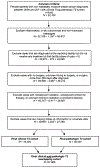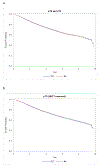Breast conservation versus mastectomy in patients with T3 breast cancers (> 5 cm): an analysis of 37,268 patients from the National Cancer Database
- PMID: 30343456
- PMCID: PMC6391170
- DOI: 10.1007/s10549-018-5007-4
Breast conservation versus mastectomy in patients with T3 breast cancers (> 5 cm): an analysis of 37,268 patients from the National Cancer Database
Abstract
Purpose: Breast conservation therapy (BCT) is standard for T1-T2 tumors, but early trials excluded breast cancers > 5 cm. This study was performed to assess patterns and outcomes of BCT for T3 tumors.
Methods: We reviewed the National Cancer Database (NCDB) for noninflammatory breast cancers > 5 cm, between 2004 and 2011 who underwent BCT or mastectomy (Mtx) with nodal evaluation. Patients with skin or chest wall involvement were excluded. Patients having clinical T3 tumors were analyzed to determine outcomes based upon presentation, with those having pathologic T3 tumors, subsequently assessed, irrespective of presentation. Overall survival (OS) was analyzed using multivariable Cox proportional hazards models, with adjusted survival curves estimated using inverse probability weighting.
Results: After exclusions, 37,268 patients remained. Median age and tumor size for BCT versus Mtx were 53 versus 54 years (p < 0.001) and 6.0 versus 6.7 cm (p < 0.001), respectively. Predictors of BCT included age, race, location, facility type, year of diagnosis, tumor size, grade, histology, nodes examined and positive, and administration of chemotherapy and radiotherapy. OS was similar between Mtx and BCT (p = 0.36). This held true when neoadjuvant chemotherapy patients were excluded (p = 0.39). BCT percentages declined over time (p < 0.001), while tumor sizes remained the same (p = 0.77). Median follow-up was 51.4 months.
Conclusions: OS for patients with T3 breast cancers is similar whether patients received Mtx or BCT, confirming that tumor size should not be an absolute BCT exclusion. Declining use of BCT for tumors > 5 cm in younger patients may be accounted for by recent trends toward mastectomy.
Keywords: Breast conservation; Locally advanced breast cancer; Mastectomy.
Conflict of interest statement
Conflict of Interest: This work was supported by United States Public Health Services grant P30 CA006927 for analysis of the data via support of our biostatistics facility, and by generous private donor support from the Marlyn Fein Chapter of the Fox Chase Cancer Center Board of Associates, for analysis and interpretation of the data.
The authors otherwise have no potential conflicts of interest.
Figures





Similar articles
-
Breast conservation versus mastectomy for patients with T3 primary tumors (>5 cm): A review of 5685 medicare patients.Cancer. 2016 Jan 1;122(1):42-9. doi: 10.1002/cncr.29726. Epub 2015 Oct 19. Cancer. 2016. PMID: 26479066 Free PMC article.
-
Loco-regional control after neo-adjuvant chemotherapy and conservative treatment for locally advanced breast cancer patients.Breast J. 2014 Jul-Aug;20(4):381-7. doi: 10.1111/tbj.12277. Epub 2014 Jun 2. Breast J. 2014. PMID: 24890310 Clinical Trial.
-
Breast surgery for young women with early-stage breast cancer: Mastectomy or breast-conserving therapy?Medicine (Baltimore). 2021 May 7;100(18):e25880. doi: 10.1097/MD.0000000000025880. Medicine (Baltimore). 2021. PMID: 33951002 Free PMC article.
-
Should patients with early breast cancer still be offered the choice of breast conserving surgery or mastectomy?Eur J Surg Oncol. 2016 Nov;42(11):1636-1641. doi: 10.1016/j.ejso.2016.08.016. Epub 2016 Aug 31. Eur J Surg Oncol. 2016. PMID: 27665053 Review.
-
The reciprocal influences of prognosis between two types of surgical interventions and early breast cancer patients with diverse luminal subtypes: A meta-analysis.Medicine (Baltimore). 2019 Mar;98(11):e14912. doi: 10.1097/MD.0000000000014912. Medicine (Baltimore). 2019. PMID: 30882711 Free PMC article. Review.
Cited by
-
Breast-Conserving Therapy in Patients with cT3 Breast Cancer with Good Response to Neoadjuvant Systemic Therapy Results in Excellent Local Control: A Comprehensive Cancer Center Experience.Ann Surg Oncol. 2021 Nov;28(12):7383-7394. doi: 10.1245/s10434-021-09865-4. Epub 2021 May 12. Ann Surg Oncol. 2021. PMID: 33978889
-
Surgery paradigm for locally advanced breast cancer following neoadjuvant systemic therapy.Front Surg. 2024 Sep 6;11:1410127. doi: 10.3389/fsurg.2024.1410127. eCollection 2024. Front Surg. 2024. PMID: 39308852 Free PMC article. Review.
-
Advancing clinical staging in invasive breast carcinoma: the role of contrast-enhanced mammography.Pol J Radiol. 2025 May 7;90:e207-e214. doi: 10.5114/pjr/202229. eCollection 2025. Pol J Radiol. 2025. PMID: 40626025 Free PMC article.
-
Breast-Conserving Surgery or Mastectomy?: Impact on Survival.Ann Surg Open. 2022 Oct 5;3(4):e205. doi: 10.1097/AS9.0000000000000205. eCollection 2022 Dec. Ann Surg Open. 2022. PMID: 37600290 Free PMC article.
-
Oncoplastic Breast Conservation for Central Tumors: Definition, Classification, and the Analysis of Single Institution Experience.Plast Reconstr Surg Glob Open. 2024 May 6;12(5):e5789. doi: 10.1097/GOX.0000000000005789. eCollection 2024 May. Plast Reconstr Surg Glob Open. 2024. PMID: 38712017 Free PMC article.
References
-
- Gradishar WJ, Anderson BO, Balassanian R, Blair SL, Burstein HJ, Cyr A, Elias AD, Farrar WB, Forero A, Giordano SH, Goetz MP, Goldstein LJ, Isakoff SJ, Lyons J, Marcom PK, Mayer IA, McCormick B, Moran MS, O’Regan RM, Patel SA, Pierce LJ, Reed EC, Salerno KE, Schwartzberg LS, Sitapati A, Smith KL, Smith ML, Soliman H, Somlo G, Telli ML, Ward JH, Kumar R, Shead DA (2018) Breast Cancer, Version 4.2017, NCCN Clinical Practice Guidelines in Oncology. J Natl Compr Canc Netw 16 (3):310–320. doi:10.6004/jnccn.2018.0012 - DOI - PubMed
-
- National Accreditation Program for Breast Centers. NAPBC Standards Manual 2018 Edition (2018). In: Surgeons ACo; (ed)
Publication types
MeSH terms
Grants and funding
LinkOut - more resources
Full Text Sources
Medical

